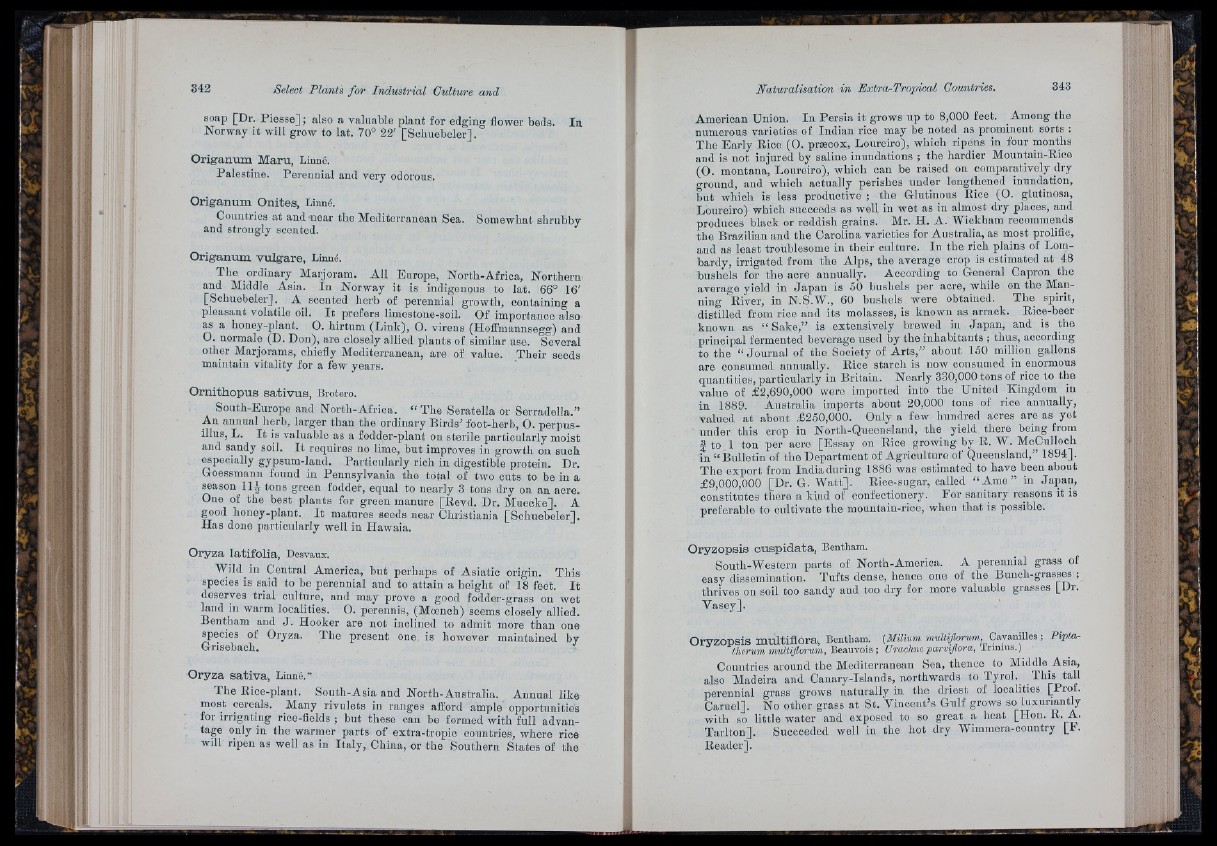
Ilì ii
■ti:
m
Select Plants fo r Industrial Culture and
soap [Dr. Piesse] ; also a valuable plant for edging flower beds.
Norway it will grow to lat. 70° 22' [Schuebeler].
Origanum Maru, Linné.
Palestine. Perennial and very odorous.
In
Origanum Onites, Linné.
Countries at and ‘near the Mediterranean Sea.
and strongly scented.
Somewhat shrubby
Origanum vulgare, Linné.
The ordiuary^ Marjoram. All Europe, North-Africa, Northern
and Middle Asia. In Norway it is indigenous to iat. 66° 16'
[Schuebeler]. A scented herb of perennial growth, containing a
pleasant volatile oil. I t prefers limestone-soil. Of importance also
^ a honey-plant. O. hirtum (Link), O. virens (Hoffmannsegg) and
O. normale (D. Don), are closely allied plants of similar use. Several
other Marjorams, chiefly Mediterranean, are of value. Their seeds
maintain vitality for a few years.
Ornithopus sativus, Brotero.
Sonth-Europe and North-Africa. “ The Seratella or Serradella.”
An annual herb, larger than the ordinary Birds’ foot-herb, O. perpus-
illus, L. I t is valuable as a fodder-plant on sterile partioularly moist
and sandy soil. I t requires no lime, but improves in growth on such
especially gypsum-land. Particularly rich iu digestible protein. Dr.
Goessmann found in Pennsylvania the total of two cuts to be in a
season 11^ tons green fodder, equal to nearly 3 tons dry on an acre.
One of the best plants for green manure [Kevd. Dr. Muecke]. A
good honey-plant. I t matures seeds near Christiania [Schuebeler].
Has done particularly well in Hawaia.
Oryza latifolia, Desvaux.
Wild in Central America, but perhaps of Asiatic origin. 'This
species is smd to be perennial and to attain a height of 18 feet. I t
deserves trial culture, and may prove a good fodder-grass on wet
land in warm localities. O. perennis, (Moenoh) seems closely allied.
Bentham and J . Hooker are not inclined to admit more than one
species of Oryza. 'The present one is however maintained by
Grisebach.
Oryza sativa, Linné.*
'The Rice-plant. South-Asia and North-Australia. Annual like
most cereals. Many rivulets in ranges afford ample opportunities
for irrigating rice-flelds ; but these can be formed with full advantage
only in the warmer parts of extra-tropic countries, where rice
will ripen as well as in Italy, China, or the Southern States of the
American Union. In Persia it grows up to 8,000 feet. Among the
numerous varieties of Indian rice may be noted as prominent sorts :
The Early Rice (O. prasoox, Loureiro), which ripens in four montlis
and is not injured by saline inundations ; the hardier Mountain-Rice
(O. montana, Loureiro), which can be raised on comparatively dry
ground, aud which actually perishes under lengthened inundation,
but which is less productive ; the Glutinous Rice (0 . glutinosa,
Loureiro) which succeeds as well in wet as iu almost dry places, and
produces black or reddish grains. Mr. II. A. Wickham recommends
the Brazilian and the Carolina varieties for Australia, as most prolific,
and as least troublesome in their culture. In the rich plmns of Lombardy,
irrigated from the Alps, the average crop is estimated at 48
bushels for the aere annually. According to General Capron the
average yield in Jap an is 50 bushels per acre, while on the Manning
River, in N.S.W., 60 bushels were obtained. The spirit,
distilled from rice and its molasses, is known as arrack. Rice-heer
known as “ Sake,” is extensively brewed in Japan, and is the
principal fermented beverage used by the inhabitants ; thus, according
to the “ Journal of the Society of Arts,” about 150 million gallons
are consumed annually. Rice starch is now consumed in miormous
quantities, particularly iu Britain. Nearly 330,000 tons of rice to the
value of £2,690,000 were imported into the United Kingdom in
in 1889. Australia imports about 20,000 tons of rice annually,
valued at about £250,000. Only a few hundred acres are as yet
under this crop in North-Queensland, the yield there being from
I to 1 ton per acre [Essay on Bice g r o w i n g by R. W. MoCulloch
in “ Bulletin of the Department of Agriculture of Queensland,” 1894].
The export from India during 1886 was estimated to have been about
£9,000,000 [Dr. G. W a tt]. Rice-sugnr, called “ Arne” in Japan,
constitutes there a kjnd of confectionery. For sanitary reasons it is
preferable to cultivate the mouutaiu-rice, when that is possible.
Oryzopsis cuspidata, Bentham.
South-Western parts of North-America. A perennial grass of
easy dissemination. Tufts dense, hence one of the Bunch-grasses ;
thrives on soil too sandy and too dry for more valuable grasses [Dr.
Vasey].
Orvzopsis multiflora, Bentham. (Milmm multifiorum, Cavanilles; Piptatherum
multifiorum, T&eamoiii-, Uraclmeparviflora, Tvmiwii.)
Countries around the Mediterranean Sea, thence to Middle Asia,
also Madeira and Canary-Isiands, northwards to Tyrol.^ This tall
perennial grass grows naturally in the driest of localities [Prof.
Caruel]. No other grass at St. Vincent’s Gulf grows so luxuriantly
with so little water and exposed to so great a heat [Hon. R. A.
Tarlton]. Succeeded well in the hot dry Wimmera-country [ I .
Reader].
ill